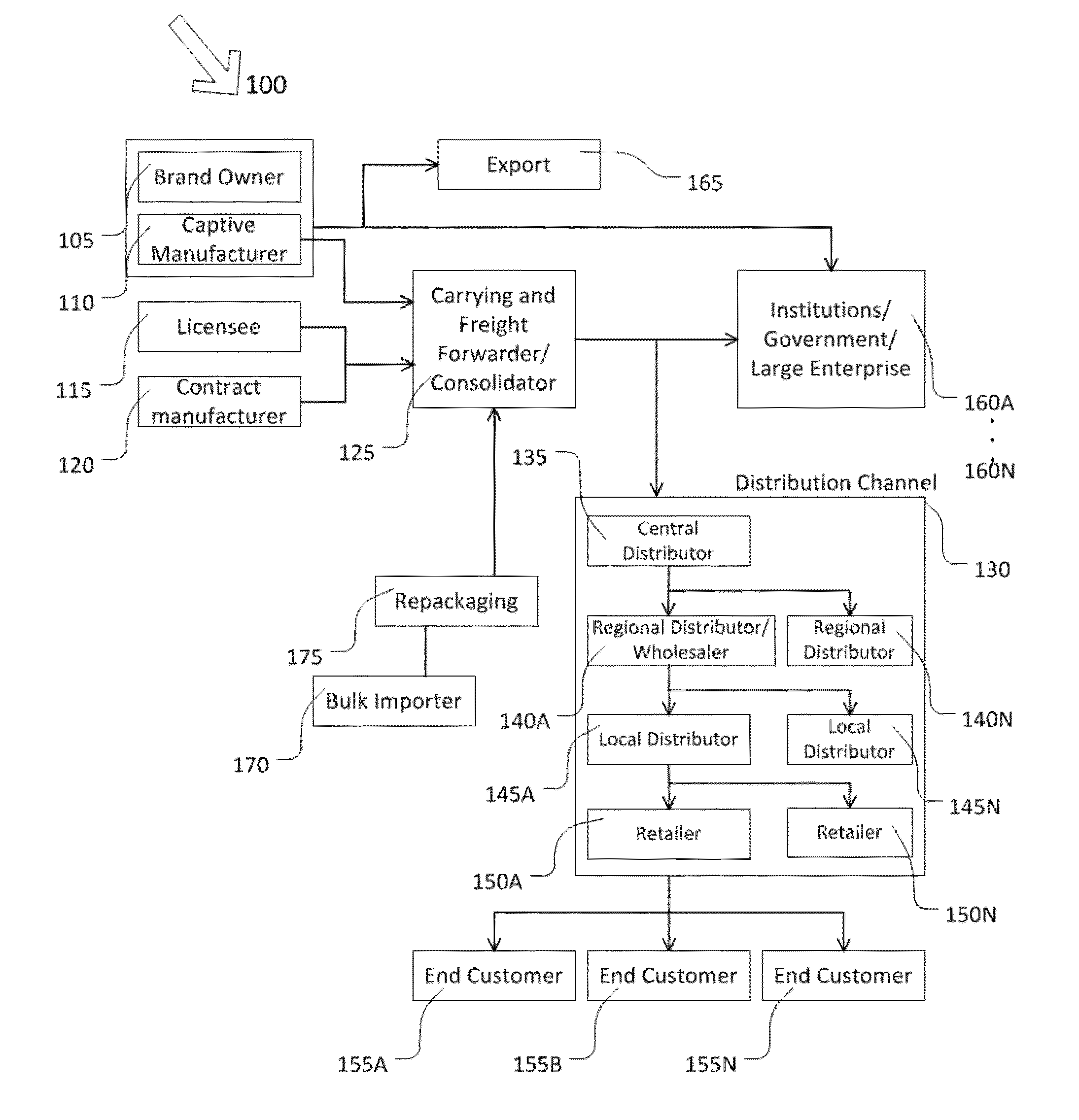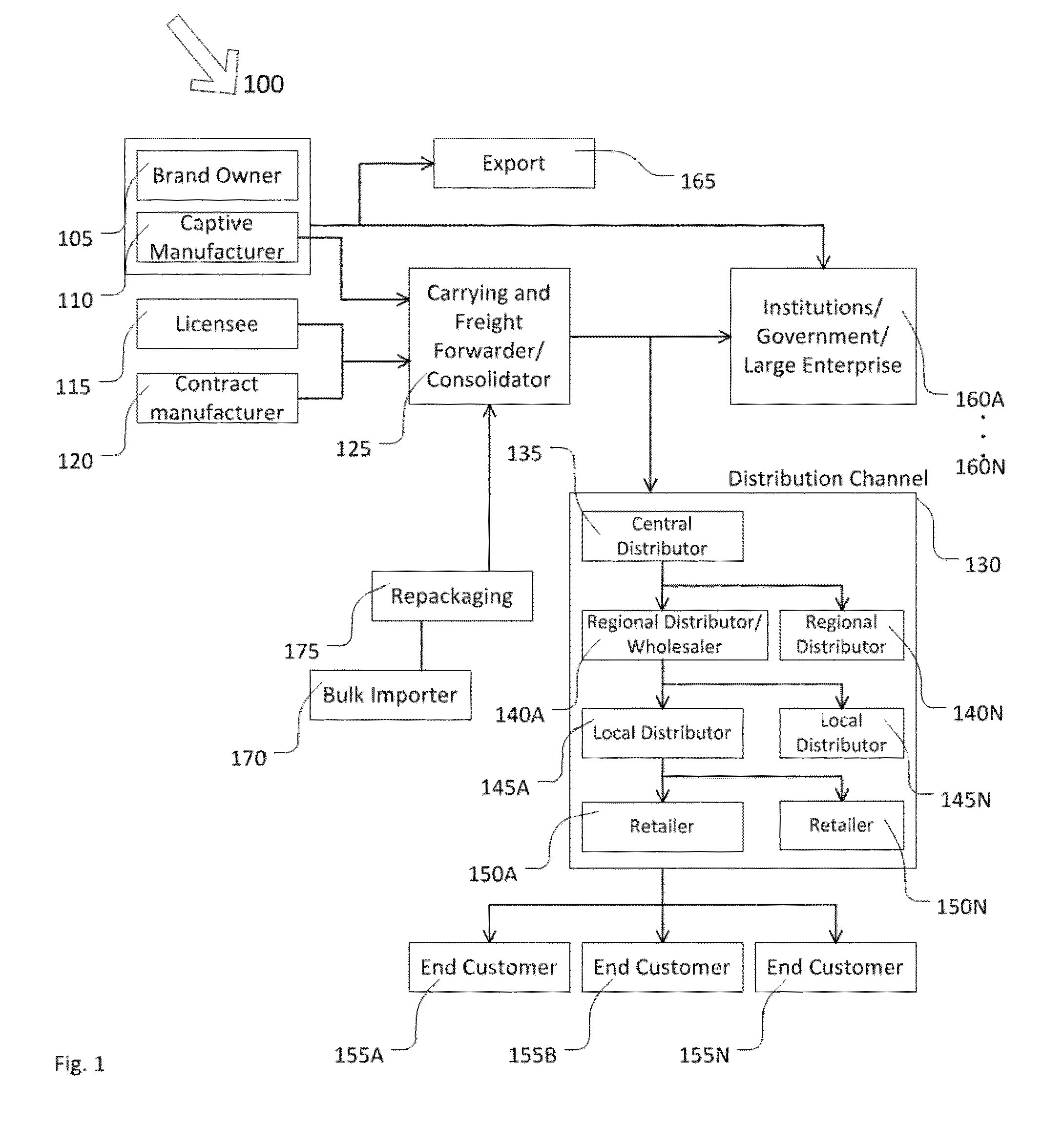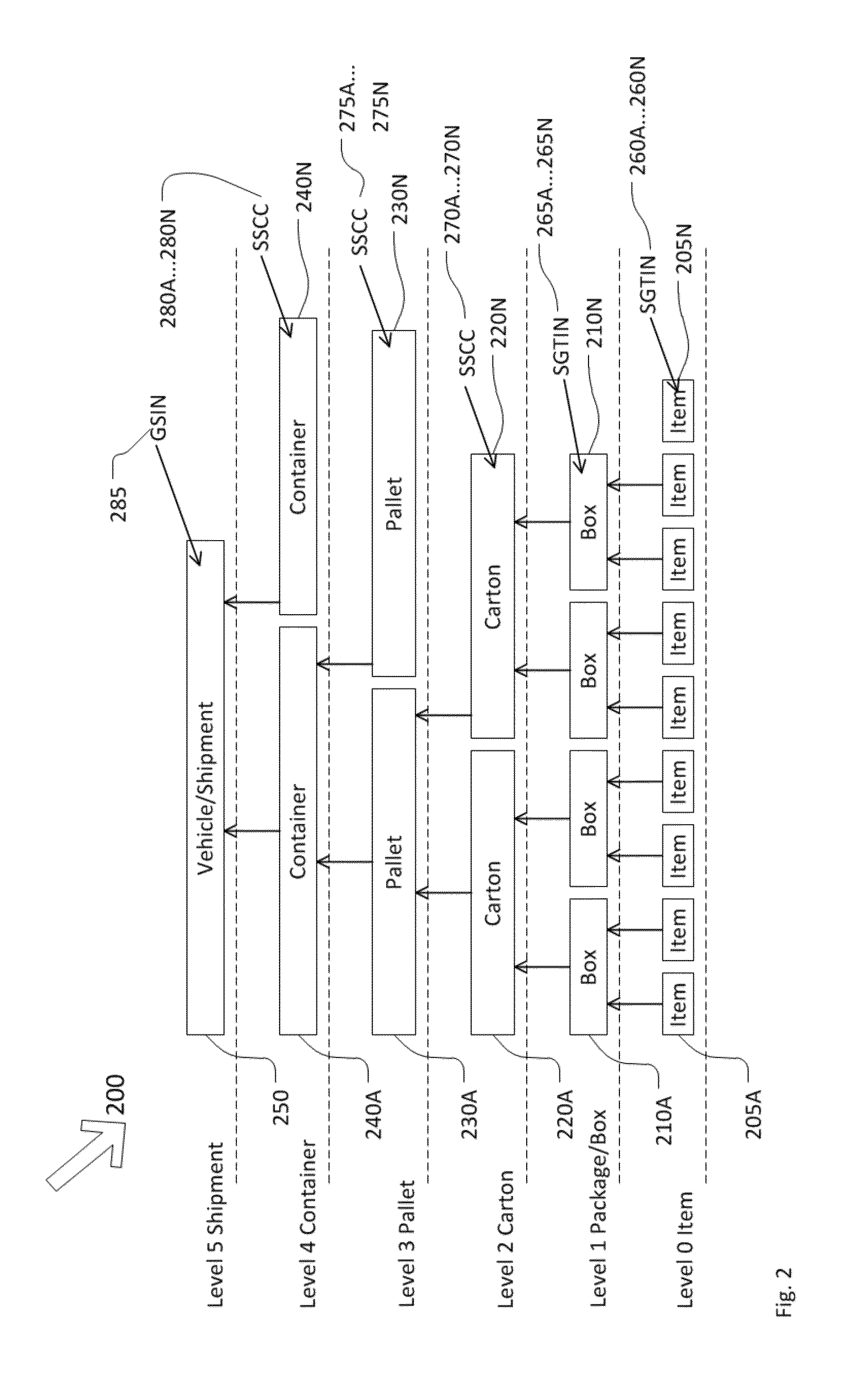Modern supply chains are quite complex and encompass multiple companies as brand owners / organizations / companies attempt to manage the movement of raw materials to finished trade items, and then through various distribution channels and intermediaries and retailers to users or end customers.
Without having a secure supply chain that cannot be compromised by unscrupulous parties, it is difficult for brand owners to be certain that the consumers are indeed receiving authorized or genuine articles through channels authorized and approved by the brand owners.
However, counterfeiters, thieves, product diverters, product overflow companies and like parties have also become quite sophisticated in compromising these security systems.
As a result, serious problems continue to plague the security and integrity of supply chains.
It is, therefore, highly likely that a large number of parties have access to the articles along the supply chain.
One major cause of concern to brand owners is product overruns.
One month a product may be manufactured in one part of the world, and the following month the same product may be manufactured in another factory in another part of the world due to a shortage of raw materials, regional conflicts, customs problems, shifts in customer demands, labor strikes, and transportation and labor costs.
Sometimes some of these subcontractors produce more than the quantity requested by the brand owners.
The additional products, also known as product overruns, produced in this manner are then distributed through unauthorized / illegal channels depriving the brand owners of their just revenue and profit.
Article diversion is another major issue faced by a brand owner and typically takes place during the distribution of articles on a global scale.
Some unscrupulous companies who specialize in export diversion buy branded products intended for untapped foreign markets at deep discounted prices.
They then divert or ship these products into established markets and illegally resell them to dealers and retailers in the established markets for a significant profit and, in turn, deprive the brand owners of their rightful revenue and profit.
However, the products may sometimes be diverted to low-end discount stores.
This can occur, for example, if the products in the high-end store are not moving, and there is an excess inventory.
It is difficult, however, to find out which high-end retailer was responsible for product diversion.
As such, products may be illegally distributed, diverted and smuggled to avoid taxes.
This problem has reached a monumental scale and, in addition, excise tax evasion also contributes to income tax evasion and creates a black market economy.
However, excise stamps can be counterfeited.
The problem of identifying the origin of the products and tracking their movement from the source point to the consumers, therefore, extends worldwide.
Still another problem of importance is that of theft in the supply chain.
Vans and trucks carrying high value goods such as expensive apparel, alcohols, and accessories are often hijacked.
In addition to product overruns, diversion and theft at various points in the supply chain, another major problem is that of counterfeit products entering the supply chain in multiple ways.
It is becoming very difficult for the brand owners to find out where the counterfeit products are entering in their supply chains.
Honest freight consolidators, central distributors, regional distributors, and retailers have no way of knowing if a shipment of the products that they received for further movement along the supply chain is really authorized or authentic.
Problems of counterfeiting are worsening due to globalization, causing loss of revenue for brand owners, and threatening
intellectual property rights and investment in research and development.
Counterfeiting also carries a negative
impact on a brand image when customers realize that the quality of the branded product may not be what they have paid for.
Finally, consumers have little way of knowing whether the products that they bought are authorized or unauthorized.
If a
consumer bought a product believing the product to be authentic, and then, if not satisfied, attempts to return the product to the brand owner, then the
consumer will be frustrated if the brand owner refuses to accept the product.
At times, the brand owner may not be able to differentiate a genuine product from a fake returned product.
This causes increased warranty and repair costs for the brand owner in addition to lost reputation.
There have been instances where the brand owner had to recall products from the market, because it was difficult for the brand owner to prove that the products the consumers bought were not their products.
However, RFID tags can be tampered with by unscrupulous parties, and barcoded labels can be easily copied.
However, a counterfeiter may simply copy the unique codes and produce multiple products with the same unique code.
None of the present technologies are effective in either preventing counterfeiting, diversion, product overruns or theft, or in preventing any unauthorized articles from entering the supply chain.
To date, brand owners have no tools to track the integrity of the supply chain in real time, or to know the location and time where and when the supply chain has been breached.
Unauthorized, counterfeit, or diverted articles, or product overruns, can enter and exit the supply chain at any point.
Authorized / genuine articles may exit and be diverted into unauthorized / illegal channels at any point.
The more complex and lengthy the supply chain 100 is, the more possibilities exist for unauthorized activity to flourish.
Since the
microstructure depends on the physical factors introduced in manufacturing and is unpredictable, each challenge-response behavior is different and unpredictable, and this property may be used for authentication.
It is almost impossible for any company including the one who created the first tag to be able to recreate an identical tag.
However, the brand owner then has limited controls over these outside manufacturers.
The product overruns may bear the brand mark, but the brand owner is deprived of its rightful revenue and profit.
Unscrupulous parties continue to devise ingenious means to defeat the authorized channels that the brand owner counts on.
Counterfeiters may find dishonest central distributors, regional or local distributors, and retailers, and use these relationships to push counterfeit articles to the end customers.
A significant amount of stealing takes place during transportation as the articles move from one location to another.
If the ID was in the
database and was activated, but the
label was found to be unauthentic, it signifies that the ID has been faked by unscrupulous parties in the supply chain.
Retailers may have ordered too many products and may request a refund if all the products did not move to the end customer.
A problem in the reverse supply chain that the brand owner faces is that the products returned for credit may not have been authentic or authorized, and may have not belonged to the brand owner.
However, the authorized facility 1180 has heretofore had no easy way to identify and authenticate the products, because the counterfeited products may have been produced by the same manufacturer who produced the brand owner's products (overruns), or by counterfeiters who have become extremely sophisticated.
However, the detective agencies have heretofore had no tools to track and authenticate an article of commerce's movement along the supply chain.
However, this type of investigation is not in real time and is of limited value to secure the supply chain.
If there is no match, then the article is deemed illegal / counterfeit / diverted / overrun / stolen.
Retailers / customers may have ordered too many articles and may request a refund if the articles did not move in the market.
However, when the logistical units arrived at the Tianjin port at point 1615 at 10:00 am local time on the date of Oct. 15, 2011, five of the logistical units were found to be illegal.
However, at point 1630, only forty logistical units were found to be legal, and five were found to be illegal / fake.
However, at point 1635, only thirty-five logistical units were found to be legal, and five were found to be illegal / fake.
However, at point 1640, only thirty logistical units were found to be legal, and five were found to be illegal / fake.
However, the problem areas could be product overruns at the factory, or at the freight consolidator, or at the exporter / importer, or at the institutional users, or at the central
distributor, or at the regional or local distributors, or at transporters between any points, or at any combination of these or additional entry and exit points in the supply chain.
Overruns, diversion, counterfeiting, and theft, etc. are all part of the unauthorized / illegal supply chain.
 Login to View More
Login to View More  Login to View More
Login to View More 


